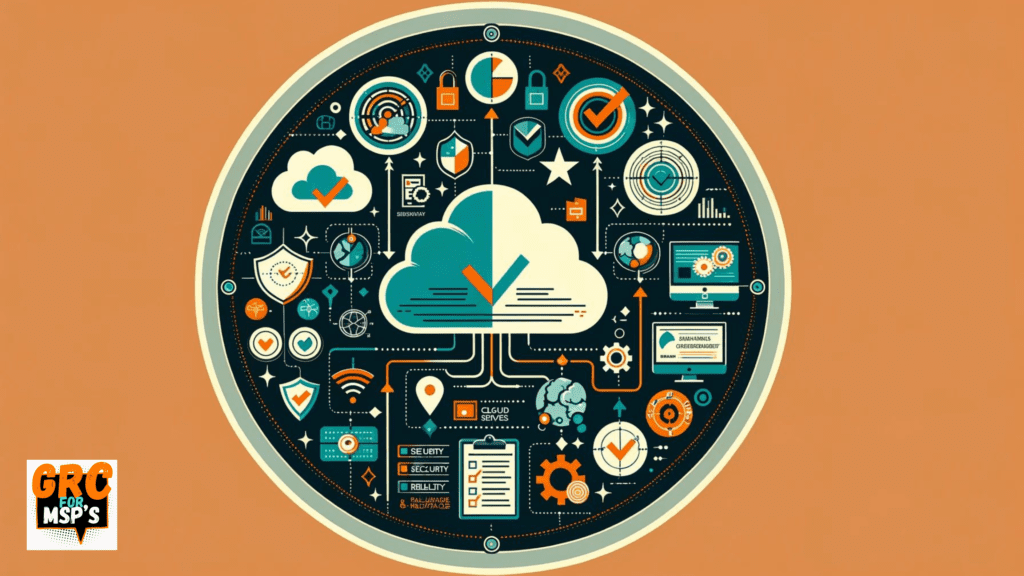Managed Service Providers (MSPs) face unique challenges when it comes to the security of the cloud services they offer. As such, compliance with the ISO 27001:2022 standard, specifically Annex A.5.23, is crucial for the establishment of robust information security measures. This addition to the ISO 27001 framework sets forth requisites for MSPs on how to handle cloud services securely, encompassing processes from acquisition and use to management and termination. With the prevalence of cloud computing, adhering to these guidelines is key to safeguarding both the MSP’s interests and those of their clients.

Annex A.5.23 emphasises a systematic approach to managing and protecting data within the cloud. It encompasses determining and implementing appropriate controls for a secure cloud environment, defining usage policies, and ensuring ongoing compliance with legal, regulatory, and contractual obligations. This approach not only minimises the risks associated with cloud services but also fortifies an MSP’s commitment to continuous improvement in their security measures. For MSPs, translating these requirements into actionable procedures is essential to maintain a secure and trustworthy cloud service provision.
Key Takeaways
- Annex A.5.23 outlines vital processes for MSPs to securely manage cloud services.
- Adherence to the guidelines ensures data security and compliance in cloud computing.
- MSPs must translate ISO requirements into concrete security controls and procedures.
Understanding MSP ISO 27001:2022 A.5.23 Requirements
The recent update to the ISO 27001 standard introduced specific controls that apply to the management of cloud services. Managed Service Providers (MSPs) must establish and maintain processes that uphold information security when engaging with cloud technologies. This is detailed in Clause A.5.23 of ISO 27001:2022.
Key elements of A.5.23 include:
Acquisition: Organisations need to ensure secure procurement processes are in place when obtaining cloud services. Due diligence is paramount to assess the suitability and security provisions of the service provider.
Use: The utilisation of cloud services should align with the company’s information security policies. User access management and data protection protocols are critical during operation.
Management: Continuous monitoring and management of cloud services safeguard against evolving threats. Incident response plans and security reviews are part of effective governance.
Exit: When terminating cloud services, MSPs must ensure data is securely removed or transferred and that all access rights are revoked accordingly.
The following table summarises the responsibilities of MSPs under this clause:
| Process | Responsibility |
|---|---|
| Acquisition | Secure procurement and due diligence |
| Use | Policy adherence and user access control |
| Management | Continuous monitoring and security reviews |
| Exit | Secure data removal and access termination |
This clause emphasises the importance of considering the full lifecycle of cloud services. By doing so, Managed Service Providers ensure their clients’ information remains secure in an ever-changing digital landscape. The adoption of ISO 27001:2022 standards is critical for MSPs seeking to enhance their information security practices and build trust with stakeholders.
Assessing Cloud Service Providers

When engaging with cloud service providers, Managed Service Providers (MSPs) must meticulously assess compliance and risk factors. MSPs are obligated to ensure that the cloud services utilised meet the stringent requirements outlined in ISO 27001:2022 A.5.23.
Vendor Compliance Evaluation
MSPs must first evaluate a cloud service provider’s adherence to privacy and security standards. This includes a thorough review of their certifications and adherence to both international and industry-specific regulations. A useful method is to construct a compliance matrix, listing the essential ISO standards and regulatory requirements and verifying the provider’s certifications against these benchmarks.
- ISO 27001 Certification: Confirms a provider’s commitment to information security.
- Data Protection Regulations: E.g., GDPR, which mandates strict data handling practices.
- Service Organisation Controls (SOC): SOC 2 Type II is particularly important for cloud service assurance.
Risk Assessment and Management
Assessing potential risks when utilising cloud services is imperative. MSPs must systematically identify, evaluate, and mitigate risks associated with the deployment of cloud services.
- Identify: Enumerate possible security and privacy risks.
- Evaluate: Assess the likelihood and potential impact of each risk.
- Mitigate: Develop strategies to manage, reduce, or transfer identified risks.
Risk Matrix Example:
| Risk Factor | Likelihood | Impact | Mitigation Strategy |
|---|---|---|---|
| Data Breach | Moderate | High | Implement encryption and two-factor authentication |
| Service Downtime | Low | Medium | Establish a robust incident response plan |
MSPs ensure that the adoption of cloud services aligns with their own risk management framework and the expectations set forth by ISO 27001:2022 A.5.23, thus achieving a secure and resilient cloud environment.
Implementing Information Security Controls
In the context of MSP ISO 27001:2022 A.5.23, implementing effective information security controls is crucial when using cloud services. These controls are centred around safeguarding data, regulating access, and responding to security incidents.
Data Protection Measures
Organisations must adopt robust data protection measures to comply with ISO 27001:2022 A.5.23. They must encrypt sensitive data, both at rest and in transit, to mitigate risks of unauthorised access and data breaches. Additionally, it is essential to employ data masking and tokenisation where feasible to further enhance the security of data stored in the cloud.
Access Management Protocols
Effective access management protocols ensure that only authorised personnel have access to cloud-based resources. Organisations should implement multi-factor authentication (MFA) and maintain meticulous access logs. It’s imperative to regularly review these access controls to ensure their ongoing appropriateness and to adjust permissions in accordance with personnel changes.
Incident Response Planning
An organised incident response plan must be in place to address potential security issues swiftly. This plan should outline clear procedures for incident detection, reporting, and resolution. Organisations need to ensure they have a well-trained incident response team ready to act in accordance with the predefined processes to minimise the impact of any security incidents.
Cloud Service Usage Policies and Procedures

Cloud Service Usage Policies and Procedures are essential to ensure the security and management of cloud services. They encompass guidelines for employee use and systematic audits and monitoring.
Employee Guidance on Cloud Usage
Organisations should provide clear instructions for their employees on the proper use of cloud services. This must include:
- Approved cloud service providers
- Procedures for data storage and transfer
- Restrictions on sensitive data storage
It is imperative that employees are not only informed but also routinely trained on these guidelines to mitigate security risks.
Audit Trails and Monitoring
Thorough audit trails and consistent monitoring form the backbone of cloud service security. Companies must implement:
- Logging of user activities, access, and system changes
- Regular review processes for the audit logs
- Real-time alerts for any unauthorised activities
This helps in detecting and responding to potential threats in a timely manner.
Continual Improvement and Review
In accordance with ISO 27001:2022 A.5.23, organisations are encouraged to establish robust procedures to manage their use of cloud services effectively. These processes involve the implementation of practices for the acquisition, use, management, and eventual cessation of cloud services.
Continual improvement is a vital aspect of an Information Security Management System (ISMS). Organisations should regularly assess and enhance their cloud service security measures by:
- Conducting periodic audits to ensure compliance with the standard and internal policies.
- Reviewing security incident reports to identify and remediate gaps in cloud service protection.
- Gathering and analysing feedback from users of the cloud services to identify potential improvements.
- Monitoring the latest developments in cloud technology and adjusting the strategies accordingly.
| Activity | Description |
|---|---|
| Audits | Regularly scheduled to check adherence to standards. |
| Incident Reviews | Analysing breaches or failures to improve security protocols. |
| User Feedback | Integral for identifying practical loopholes and areas for enhancement. |
| Technology Monitoring | Keeping pace with innovations to maintain a robust security posture. |
These actions are not isolated events but part of a continuous cycle that must adapt to the changing landscape of cloud services. Organisations should ensure that their approach to cloud service security is proactive, taking steps to anticipate and address potential risks before they materialise. The process of continual improvement is iterative, with learnings from each review informing the next cycle of enhancements.
Legal and Compliance Considerations

When managing cloud services under ISO 27001:2022 A.5.23, organisations must be mindful of various legal and compliance aspects. It’s imperative that they establish processes aligned with both internal policies and applicable legislation.
In the context of cloud services, there are typically key areas to consider:
Data Protection Laws: Organisations must adhere to data protection regulations such as the Australian Privacy Principles (APPs) which are part of the Privacy Act 1988 (Cth). Compliance with these principles ensures the protection of personal information handled by the organisation.
Service Level Agreements (SLAs): These should clearly define the levels of security provided by the cloud service provider. Ensuring that SLAs are in accordance with the mandatory reporting requirements is crucial.
Organisations should also take into account the:
Jurisdictional Impacts: The physical location of data centres can subject data to the laws and regulations of that territory. Therefore, understanding the implications of where data is stored, processed, and managed is essential.
Contractual Obligations: Detailed contracts with cloud service providers should outline responsibilities around data security, access, auditing, and breach notification.
By fully integrating these considerations into their information security management practices, organisations can reinforce their commitment to compliance and legal responsibilities. This strategic approach not only mitigates risks but also instills confidence amongst stakeholders that information security is taken seriously.
Frequently Asked Questions
ISO 27001:2022 introduces refined guidelines for cloud service security, including new controls and management processes. These updates are essential for ensuring compliance and maintaining robust information security within cloud environments.
How do I align my cloud services security policy with the latest ISO 27001:2022 standards?
Organisations should update their security policies to include processes for the acquisition, use, and management of cloud services. They must also ensure that these policies facilitate a smooth exit from cloud services if necessary. Detailed guidelines can be found on the ISMS.online page.
What are the essential controls for cloud security outlined in ISO 27001:2022?
The essential controls for cloud security in ISO 27001:2022 involve establishing clear guidelines for the handling of data, defining responsibilities, and implementing risk management processes.
In light of ISO 27001:2022, what incident management practices should be in place for cloud services?
Incident management practices must include mechanisms for timely detection, response, and recovery from incidents that impact cloud services. Organisations should also have procedures for documenting and evaluating these incidents.
How does ISO 27001:2022 categorise domains for secure cloud service usage and management?
ISO 27001:2022 categorises domains for secure cloud service usage and management by setting out specific topic-related controls that need to be applied. These controls help specify and manage information security tailored for cloud environments.
What steps are involved in assessing and deciding on information security events as per section 5.25 of ISO 27001:2022?
Assessing and deciding on information security events involve establishing criteria for recognising and evaluating security events, and determining when they are classified as incidents. Organisations must have a well-defined response plan.
What updates have been made to the information security policies in the ISO 27001:2022 revision for cloud services?
The ISO 27001:2022 revision places an emphasis on the secure acquisition and use of cloud services, along with the addition of various other controls aimed at cloud security. The updates also prescribe specific risk assessment and treatment processes related to cloud services.

